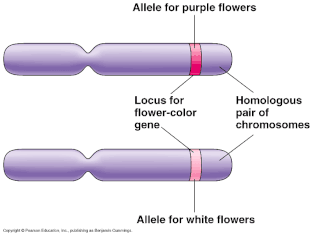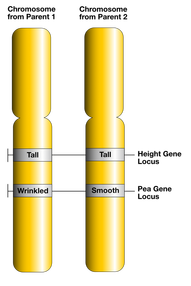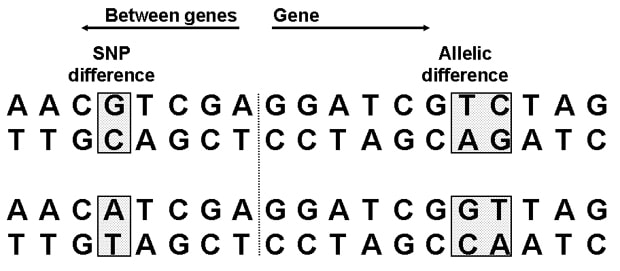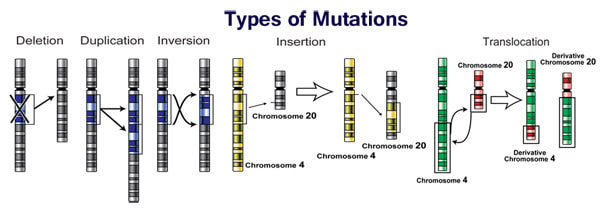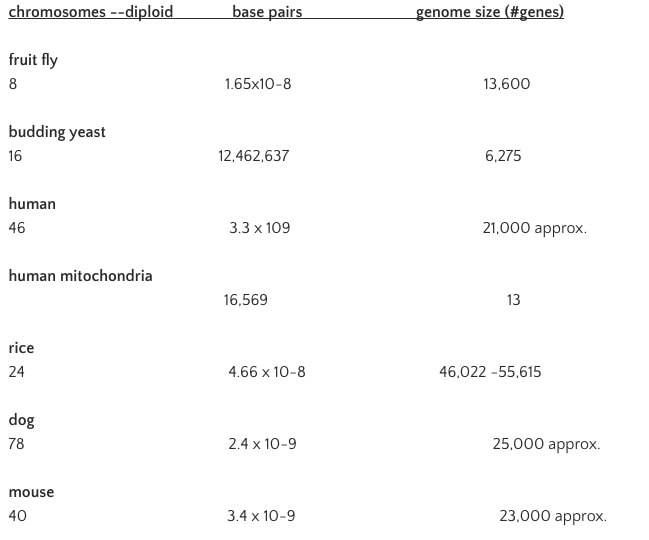topic 3.1: Genes
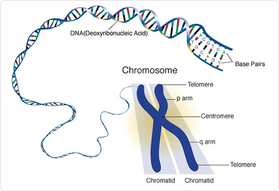
In the Genes unit students learn the structure of the chromosome and identify the consequences of a base substitution mutation.
The unit is planned to take 2 school day
The unit is planned to take 2 school day
Essential idea:
- Every living organism inherits a blueprint for life from its parents. 3.1
Nature of science:
- Developments in scientific research follow improvements in technology—gene sequencers are used for the sequencing of genes. (1.8)
Understanding:
3.1.U1 A gene is a heritable factor that consists of a length of DNA and influences a specific characteristic.
A gene is a heritable factor that consists of a length of DNA and influences a specific characteristic
Genetics is the storage of information and how this information can be passed from parents to progeny.
Genes are make up of DNA, few DNA molecules in a cell (just 46) but there are 1,000’s of genes. From this we know that each gene consists of a much shorter length of DNA than a chromosome and that each chromosome carries many genes.
Genetics is the storage of information and how this information can be passed from parents to progeny.
Genes are make up of DNA, few DNA molecules in a cell (just 46) but there are 1,000’s of genes. From this we know that each gene consists of a much shorter length of DNA than a chromosome and that each chromosome carries many genes.
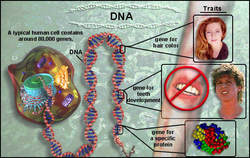 image from myweb.rollins.edu
image from myweb.rollins.edu
3.1.U2 A gene occupies a specific position on a chromosome.
A gene occupies a specific position on one type of chromosome
Genes are linked in groups, the groups each corresponds to one of the types of chromosome in a species
DNA is packaged and organised into discrete structures called chromosomes . A gene is a sequence of DNA that encodes for a specific trait (traits may also be influenced by multiple genes)
The position of a gene on a particular chromosome is called the locus (plural = loci)
Genes are linked in groups, the groups each corresponds to one of the types of chromosome in a species
DNA is packaged and organised into discrete structures called chromosomes . A gene is a sequence of DNA that encodes for a specific trait (traits may also be influenced by multiple genes)
The position of a gene on a particular chromosome is called the locus (plural = loci)
3.1.U3 The various specific forms of a gene are alleles.
Alleles are alternative forms of a gene that code for the different variations of a specific trait
For example, the gene for eye colour has alleles that encode different shades / pigments
Different heritable factors = these pairs of heritable factors are alternative forms of the same gene – etc. Heigh, one gene making the plant tall and the other making it small. This is called allele. There can be more than just two alleles of a gene
Alleles occupy the same position on one type of chromosome – same locus // only one allele can occupy the locus of the gene on a chromosome
For example, the gene for eye colour has alleles that encode different shades / pigments
Different heritable factors = these pairs of heritable factors are alternative forms of the same gene – etc. Heigh, one gene making the plant tall and the other making it small. This is called allele. There can be more than just two alleles of a gene
Alleles occupy the same position on one type of chromosome – same locus // only one allele can occupy the locus of the gene on a chromosome
3.1.U4 Alleles differ from each other by one or only a few bases.
Alleles are alternative forms of a gene that code for the different variations of a specific trait
- Genes consist of a certain sequence of DNA bases which can be 100’s to 1000’s bases in length
- Usually different alleles of the gene vary by only one to a couple of different bases.
- For example, the allele for Sickle Cell Anemia is created by a mutation of a single nucleotide.
- Adenine is switched to Thymine (CTC to CAC) which results in glutamic acid being substituted by valine at position 6 in the Hemoglobin polypeptide.
- This variation when one nucleotide is switched for another is called a single nucleotide polymorphism (SNPs for short)
3.1 U5 New alleles are formed by mutation.
A gene mutation involves a change in the nucleotide sequence of DNA and is the ultimate source of genetic diversity. New alleles are created by random changes in the base sequence called mutations.
Gene mutations can be beneficial, detrimental or neutral
- Gene mutation – random changes
- Significant types is base substitution – one base in the sequence is replaced by a different base
- These changes can either be neutral or harmful, lethal – cause the death of the cell in which the mutation occurs.
- Mutations –> develop into gametes–> passed on to offspring –> causing genetic disease
Gene mutations can be beneficial, detrimental or neutral
- Beneficial mutations change the gene sequence (missense mutations) to create new variations of a trait
- Detrimental mutations truncate the gene sequence (nonsense mutations) to abrogate the normal function of a trait
- Neutral mutations have no effect on the functioning of the specific feature (silent mutations)
3.1.U6 The genome is the whole of the genetic information of an organism.
The genome is the totality of genetic information of a cell, organism or organelle. This includes all genes as well as non-coding DNA sequences (e.g. introns, promoters, short tandem repeats, etc.
- The whole of the genetic information of an organism's genetic information is contained in DNA, therefore a living organism’s genome is the entire base sequence of each of its DNA molecules.
- In humans, the genome consists of 46 chromosomes plus the mitochondrial DNA
- In plants, the genome also consists of chloroplast DNA on top of their chromosomes and mitochondrial DNA
- Genome of the prokaryotes is much smaller and has the DNA in the circular chromosomes, plus any plasmids that are present.
- Prokaryotes have a circular chromosome and plasmids in their genome
3.1.U7 The entire base sequence of human genes was sequenced in the Human Genome Project.
The entire base sequence of human genes was sequenced in the human Genome project. The aim was to find the base sequence of the entire human genome
The completion of the Human Genome Project in 2003 lead to many outcomes:
The completion of the Human Genome Project in 2003 lead to many outcomes:
- Mapping – The number, location, size and sequence of human genes is now established
- Screening – This has allowed for the production of specific gene probes to detect sufferers and carriers of genetic diseases
- Medicine – The discovery of new proteins have lead to improved treatments (pharmacogenetics and rational drug design)
- Ancestry – Comparisons with other genomes have provided insight into the origins, evolution and migratory patterns of man
Application
3.1.A1 The causes of sickle cell anemia, including a base substitution mutation, a change to the base sequence of mRNA transcribed from it and a change to the sequence of a polypeptide in hemoglobin.
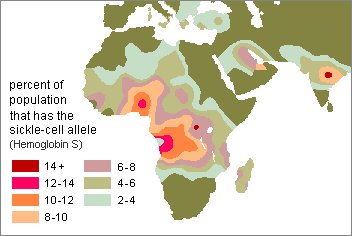
- A mutation that causes the replacement of a single base nucleotide with another nucleotide in DNA.
- When one of the bases is changed, this will cause a change in the mRNA sequence when the DNA is copied during transcription of the gene.
- This change in the mRNA sequence may change the amino acid in the polypeptide coded for by the gene; in the process of translation.
- Sickle-cell anemia is a disease that causes red blood cells to form a sickle shape (half-moon). These sickled blood cells cannot carry as much oxygen as normal red blood cells. They can cause clots in blood vessels because of their abnormal shape and inflexibility caused by crystallization of the abnormal hemoglobin.
- Sickle cell is caused by a base-substitution when the adenine base in GAG is replaced by a thymine base, changing the triplet to GTG.
- The normal triplet when transcribed and translated codes for the amino acid glutamic acid.
- When the base substitution occurs, the amino acid that is translated is now valine.
- Since valine has a different shape and charge, the resulting polypeptide’s shape and structure changes.
- As a result, hemoglobin’s shape will change, as does the shape of the red blood cell, resulting in the problems associated with sickle cell anemia listed above.
3.1.A2 Comparison of the number of genes in humans with other species.
Skills:
3.1.S1 Use of a database to determine differences in the base sequence of a gene in two species
Gene sequences from different species can be identified and then compared using two online resources:
- GenBank – a genetic database that serves as an annotated collection of DNA sequences
- Clustal Omega – an alignment program that compares multiple sequences of DNA
Key Words:
|
chromosomes
allele Sickle cell anaemia chromatid base pair sequence COX1 |
gene
genome mutation base deletion mRNA species Hb |
eukaryote
prokaryote sequence haemoglobin locus Human Genome Project polypeptide DNA sequencing |
locus
DNA blood type transcription malaria Genbank database transcription electropherogram. |
mutation
protein clotting base substitution anaemic gene mapping cytochrome oxidase |
Class Assignment:
How Genes Work
Human Genome Project activity
Sickle Cell Anemia project
Sickle Cell Anemia poster
Mutation worksheet
MOLO mutation activity
Topic 3.1 Reviewtopic_3.1_genes.docx
How Genes Work
Human Genome Project activity
Sickle Cell Anemia project
Sickle Cell Anemia poster
Mutation worksheet
MOLO mutation activity
Topic 3.1 Reviewtopic_3.1_genes.docx
Powerpoint and Notes on Topic 3.1 from Chris Payne
Your browser does not support viewing this document. Click here to download the document.
Your browser does not support viewing this document. Click here to download the document.
Correct use of terminology is a key skill in Biology. It is essential to use key terms correctly when communicating your understanding, particularly in assessments. Use the quizlet flashcards or other tools such as learn, scatter, space race, speller and test to help you master the vocabulary.
External Links:
Let’s start with a tour of the basics from Learn.Genetics at Utah.
DNA Coiling To Form Chromosomes
Chromosome Description
Video Tour of Basic Genetics
Click here for additional information on HOW GENES WORK.
Click here for some more information on Sickle Cell
DNA coiling on histone proteins from biostudio.com
A description of chromosomes from Dexter Pratt
Zooming in to Chromosome 11 (a bit too advanced) from the DNA Learning Centre’s Gene Almanac
Transcription Java game from thinkquest.org
How do mutations occur? from the DNAi at the Dolan DNA Learning Centre
In the News:
Scientists Finally Pronounce Human Genome (2013-08-15, satire)
Why Are Some People Left-Handed? (2013-09-12)
Increased Height in HFE Hemochromatosis (2013-08-22)
International-mindedness:
- Sequencing of the human genome shows that all humans share the vast majority of their base sequences but also that there are many single nucleotide polymorphisms that contribute to human diversity.
TOK:
- There is a link between sickle cell anemia and prevalence of malaria. How can we know whether there is a causal link in such cases or simply a correlation?
Video Clips:
We hear about DNA and genes all the time in the news and in our biology classes but very few of us can actually explain what a gene is? This short film is designed to help
When life emerged on Earth about 4 billion years ago, the earliest microbes had a set of basic genes that succeeded in keeping them alive. In the age of humans and other large organisms, there are a lot more genes to go around. Where did all of those new genes come from? Carl Zimmer examines the mutation and multiplication of genes.
Epigenetic inheritance is really weird, but is it real?
Animated and narrated segments presenting all the essential steps in sequencing a genome. From the NHGRI's Online Education Kit: Understanding the Human Genome Project.
In 1990, The Human Genome Project proposed to sequence the entire human genome over 15 years with $3 billion of public funds. Then, seven years before its scheduled completion, a private company called Celera announced that they could accomplish the same goal in just three years at a fraction of the cost. Tien Nguyen details the history of this race to sequence the human genome
Your genome, every human's genome, consists of a unique DNA sequence of A's, T's, C's and G's that tell your cells how to operate. Thanks to technological advances, scientists are now able to know the sequence of letters that makes up an individual genome relatively quickly and inexpensively. Mark J. Kiel takes an in-depth look at the science behind the sequence.
Sickle Cell Anemia. Written by Paulo César Naoum and Alia F. M. Naoum
Evolution of Sickle Cell: Resistance to Malaria
Epigenetics: A new frontier in heredity
